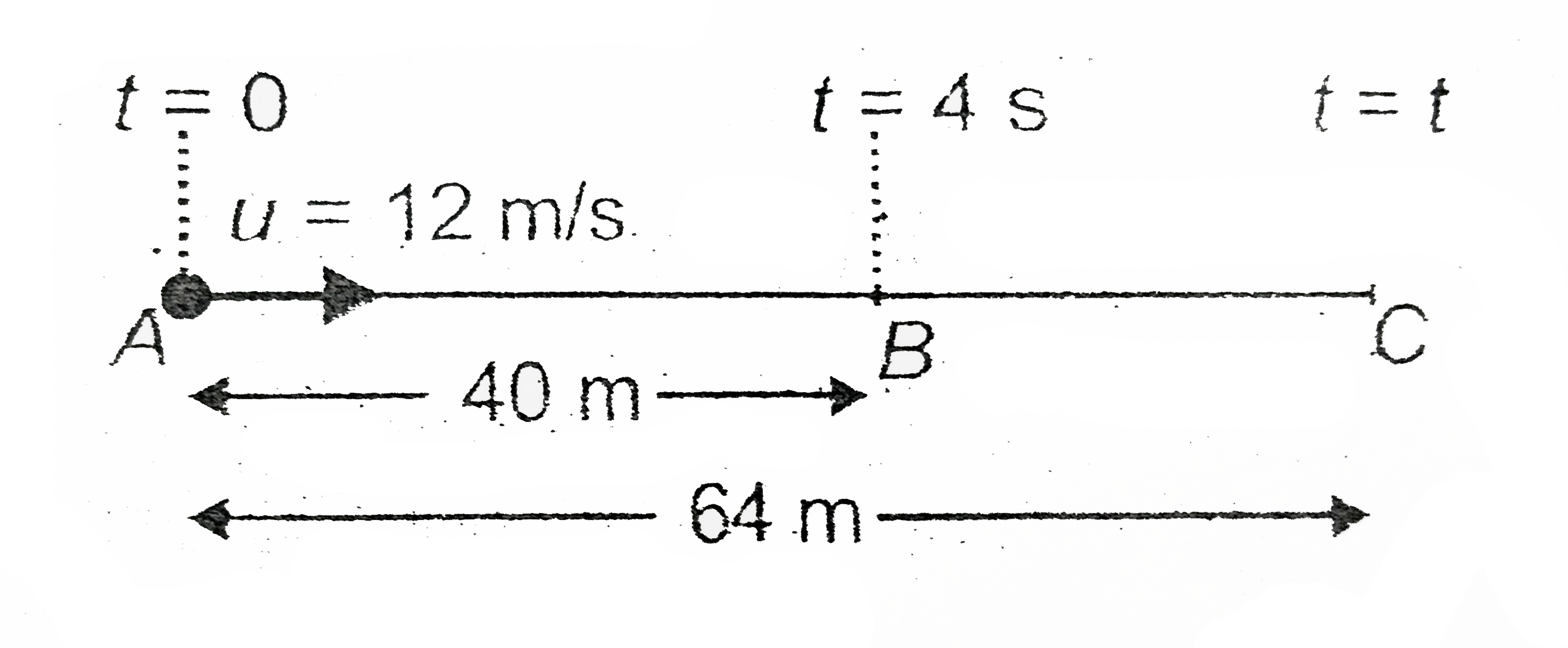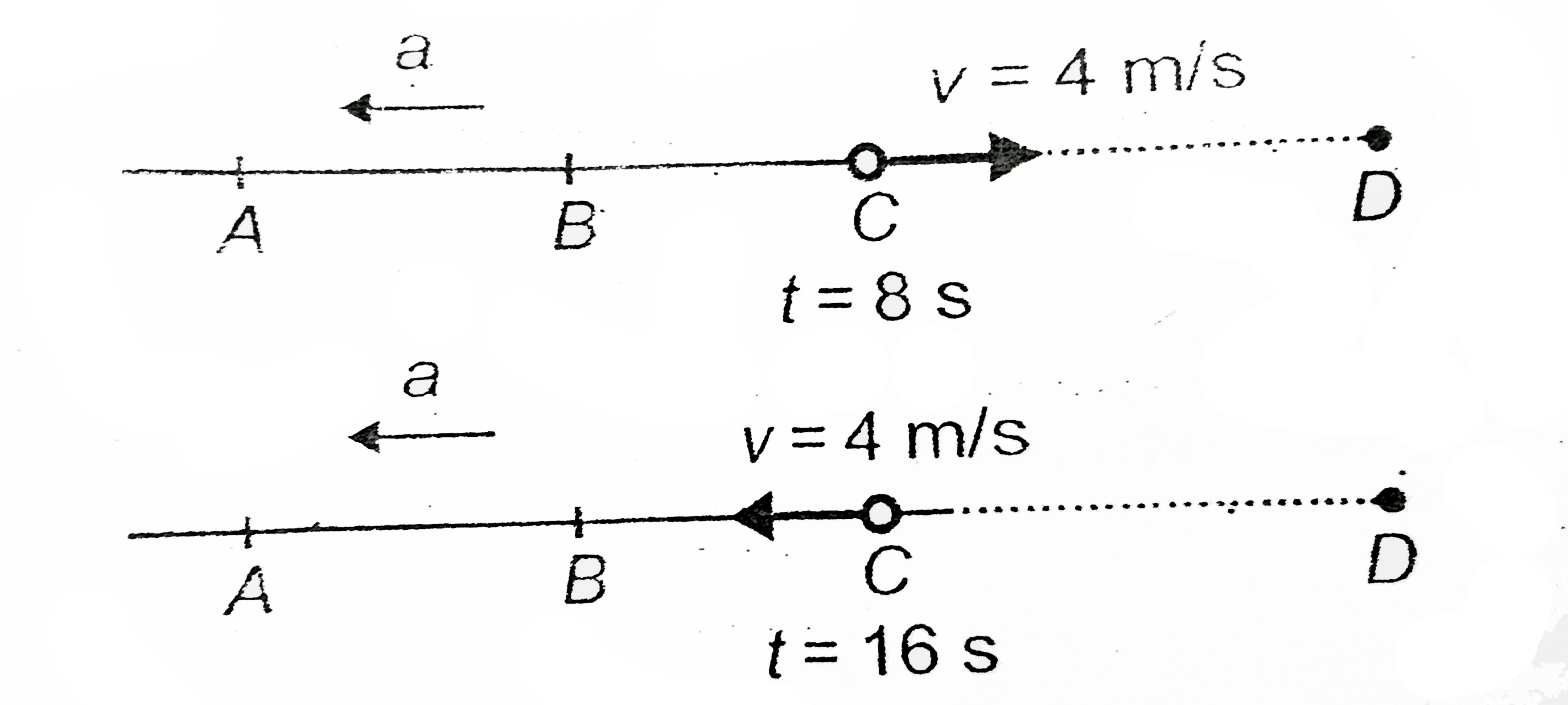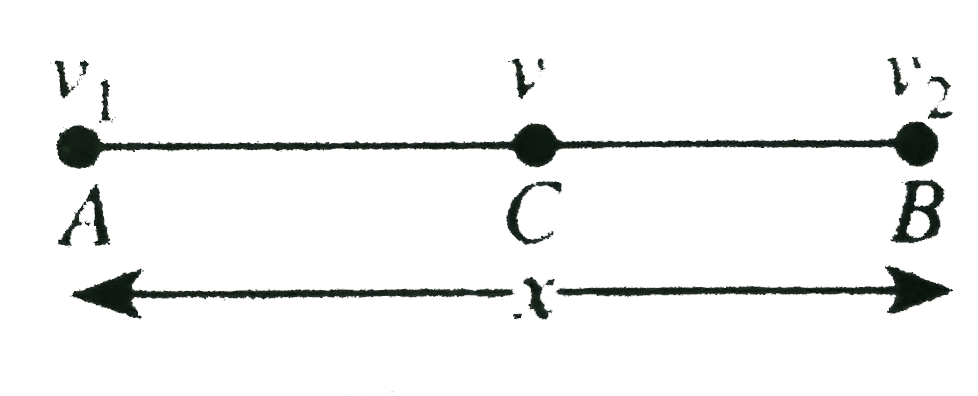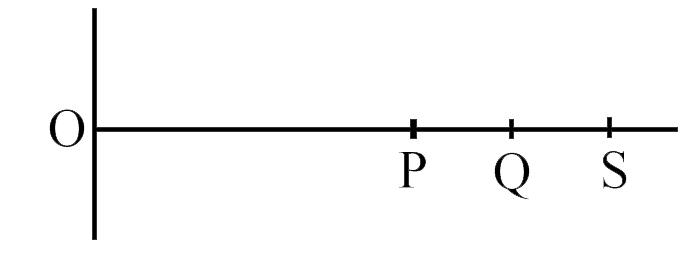A particle, moving with uniform acceleration along a straight line ABC, crosses point A at t = 0 with a velocity 12 m/s. B is 40 m from A and C is 64 m from A. The particle passes B at t = 4 s.
(a) At what time, will the particle be C?
(b) What is its velocity at C?
(a) Let the acceleration of particle be a.
For motion between A and B
u=12m/s,s=40m,t=4s
Using s=ut+12at2, we get

40=12(4)+12a(4)2
⇒a=−1m/s2
For motion between A and C
Let particle reaches C at time t.
u=12m/s,s=64m
⇒64=12t+12(−1)t2
⇒t2−24t+128=0
⇒(t−8)(t−16)=0
⇒t=8sandt=16s (why double answer?)
⇒ The particle will be at C twice, at t = 8 s and t = 16 s.
(b) Velocityk of particle at C :
At t = 8 s, velocity at C is given by v=12+(−1)×8=4m/s
and at t = 16 s velocity of particle is given by v=12+(−1)×16−4m/s

As the acceleration of particle is opposite to velocity, its speed decreases as it moves along ABC. At a point beyond C (say at D), the particle will come to rest momentarily, and then it will move backward with increasing speed and crosses point C again. This explains the double answer for time in part (a).
Topper's Solved these Questions
- BOOK - AAKASH INSTITUTECHAPTER - MOTION IN STRAIGHT LINEEXERCISE - Try Yourself40videos
MOTION IN STRAIGHT LINE
- BOOK - AAKASH INSTITUTECHAPTER - MOTION IN STRAIGHT LINEEXERCISE - Assignment (SECTION - A)50videos
MOTION IN STRAIGHT LINE
- BOOK - AAKASH INSTITUTECHAPTER - MOTION IN A STRAIGHT LINEEXERCISE - ASSIGNMENT (SECTION - D)15videos
MOTION IN A STRAIGHT LINE
- BOOK - AAKASH INSTITUTECHAPTER - MOVING CHARGE AND MAGNESIUMEXERCISE - SECTION D16videos
MOVING CHARGE AND MAGNESIUM
Similar Questions
A particle moving with uniform acceleration along a straight line ABC rosses point A at t=0 with a velocity 12ms−1. is 40m away from A andC is 64m away from A. The particle passes B at t=4 s.<br>a.Afterwˆtimewillthepartic≤beatC?<br>b.WˆisitsvelocityatC?<br>c.Wˆdoesthepartic≤reachAaga∈?<br>d.Locatethep∮wherethepartic≤reversesitsdirectionofmotion.<br>e.F∈dthedistancecoveredbythepartic≤∈thefirst15 s.
View SolutionA particle is moving with uniform acceleration along a straight line "ABC" .Its velocity at A and B are 6m/s" and "9m/s respectively. If AB:BC=5:16" then its velocity at C is
View Solution
Knowledge Check
- Question 1 - Select One
A particle is moving with uniform acceleration along a straight line ABC. Its velocity at A and B are 6 m/s and 9 m/s respectively if AB:BC=5:16 then its velocity at C is
A9.6m/s2B12m/sC15m/sD21.5m/s - Question 2 - Select One
A particle is moving with uniform acceleration along a straight line ABC, where AB= BC. The average velocity of the particle from A to B is 10 m/s and from B to C is 15 m/s. The average velocity for the whole journey from A to C in m/s is
A12B12.5C13D13.5 - Question 3 - Select One
A particle moves with uniform acceleration along a straight line AB. Its velocities at AandB are 2m/sand14m/s respectively. M is the mid-point of AB. The particle takes t1 seconds to go from A to M and t2 seconds to go from M to B. Then t2:t1 is.
A1:1B2:1C1:2D3:1
A particle moving with uniform acceleration passes the point x=2m with velocity 20m/s at the instant t=0. Some time later it is observed at the point x=32m moving with velocity 10m/s.
(a) What is its acceleration?
(b) Find its position nd velocity at the instant t=8s.
(c) What is the distance traveled during the interval t=0 to 8s?View SolutionA particle moving with uniform acceleration from A to B along a straight line has velcities v1 and v2 at A and B respectively. If C is the mid-point between A and B then determine the velocity of the particle at C .
 .View Solution
.View SolutionA particle is moving with uniform acceleration along a straight line. The average velocity of the particle from P to Q is 8ms–1 and that Q to S is 12ms–1. If QS = PQ, then the average velocity from P to S is
 View Solution
View SolutionA particle is moving with uniform acceleration along a straight line. Its velocities at A & B are respectively 7m/s & 17m/s. M is mid point of AB. If t1 is the time taken to go from A to M and t2 the time taken to go from M to B, the ratio t1t2 is equal to :-
View SolutionA particle starting from a point A and moving with a positive constant acceleration along a straight line reaches another point B in time T. Suppose that the initial velocity of the paticle is u > 0 and P is the midpoint of the line AB. If the velocity of the particle at point P is ν1, and if the velocity at time T/2 is ν2, then
View Solution

